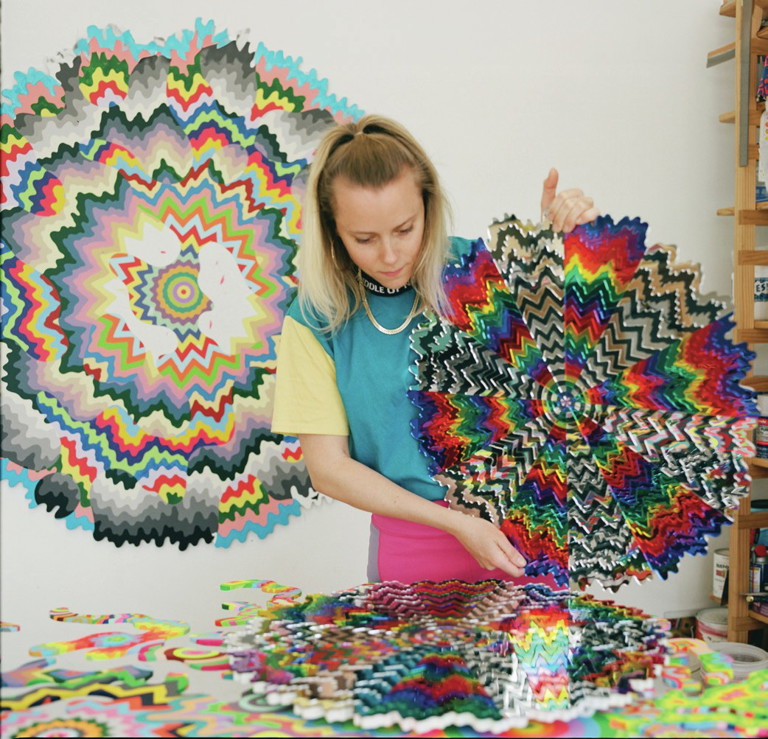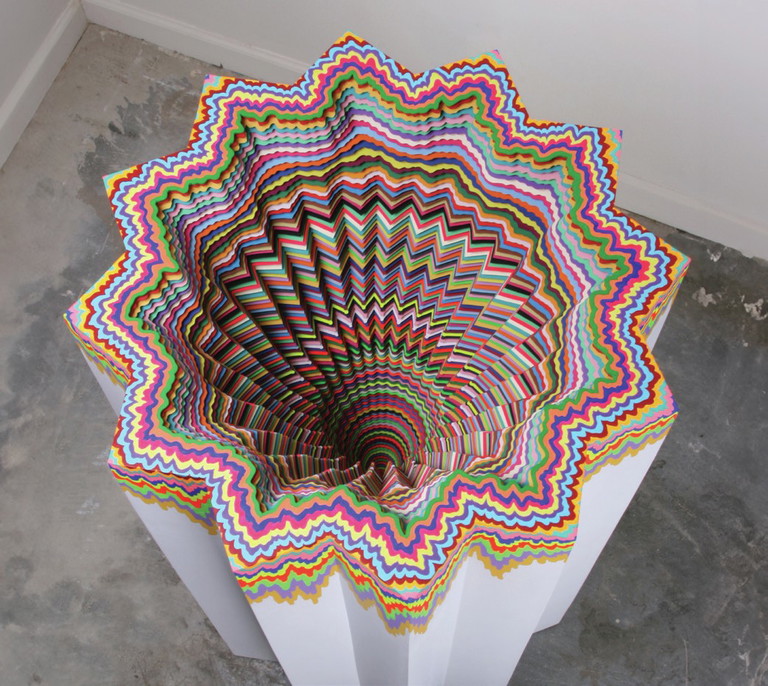CONTEMPORARY ART IN CONTEXT
Colorful Meditations
JEN STARK MULTIMEDIA ARTIST

Multimedia artist Jen Stark in her Los Angeles studio. Photo by Ira Chernova.
Drawing on mathematics and science, Jen Stark combines color, depth, and geometry to create works that resemble organic, blooming, or cloud-like structures endowed with kinetic, undulating effects in a body of work that includes sculpture, murals, intricately cut paper forms, and immersive, pulsating installations. Color pulls viewers in, encouraging them to enter an altered state of perception akin to meditation.
Layers of Nature
Stark uses color, line, and repetition to make art that visualizes growth, evolution, and infinity. She believes that spirituality draws upon the natural laws and patterns of the universe, and that examining these forces through artwork can open viewers’ eyes. Her color choices reference the natural world, such as the bright hues of f lowers that attract insects to pollinate or the brilliantly colored, glowing creatures who dwell at the bottom of the oceans.

Jen Stark, Cosmic Distortion, 2012. Hand-cut acid-free paper, glue, wood, foam board, 22½ x 22½ x 36½" (57 x 57 x 92.5 cm). Images courtesy of the artist.
Stark began using colored construction paper because itʼs inexpensive and portable, developing a process of cutting, folding, and arranging color layers. This bloomed into the dazzling constructions of her recent work, such as the laser-cut aluminum sculpture 4 x 4 x 4. Sculptures like Gradial Continuum explode the layers apart, emphasizing positive and negative space.
In Drip Cascade, Stark merges vibrant color and ever-changing digital patterns that animate her signature drips and kaleidoscope forms. Stark also works with digital media to create animated color manipulations, interactive animated projections, and NFTs.
Jen Stark, Cosmic Distortion, 2012. Hand-cut acid-free paper, glue, wood, foam board, 22½ x 22½ x 36½" (57 x 57 x 92.5 cm). Image courtesy of the artist.
Art History: Science, Nature, and Math
Since the flourishing of ancient Greek art in the West, artists have explored the connections between science and art. The ancient Greeks theorized that geometric shapes were the foundation of all forms in nature. Renaissance (ca. 1400–1600) theories about the nature of colors and the way the eye perceives them were explored by Impressionists, Post-Impressionists, and Pointillist painters such as Georges Seurat (1859–1891) and Paul Signac (1863–1935). In the 1960s and 70s, Op artists like Victor Vasarely explored the perception of movement in two dimensions with careful math, geometric shapes, and brilliant color.
In the twenty-first century, Op art expanded into digitally produced, immersive installations, such as the dizzying environments produced by Yayoi Kusama (b. 1929).
About the Artist
Jen Stark was born in Miami, where her grandfather taught her how to paint seashore scenes. The lush flora and diverse cultures in Florida inspired her fascination with universal patterns in nature. In 2005, she earned a BFA in fiber arts with a minor in animation from the Maryland Institute College of Art in Baltimore. Stark has exhibited in New York, Los Angeles, Miami, Thailand, and Canada. She was named to Fortune magazine’s “NFTy 50” as the first female artist to rank among Foundation’s top ten NFT artists. She lives and works in Los Angeles.
Jen Stark, 4 x 4 x 4, 2021. Powder-coated aluminum, chrome-plated aluminum spacers, aluminum threaded rods, stainless steel, and magnets, 48 x 48 x 48" (122 x 122 x 122 cm). Images courtesy of the artist.
ARTIST Q&A
What are some of the biggest influences on your work?
JS: Some of my artist influences include Yayoi Kusama, Tom Friedman, and Tara Donovan. All of these artists have a similar theme of accumulation, color, and concept. For outside inspiration, I enjoy going to music festivals with large-scale projections and animations. I recently went to my second Burning Man, and I love the incredible art installations and beautiful energy it brings. I collect kaleidoscopes and pop-up books for visual inspiration. I also like to garden and have an assortment of cactuses and succulents. Plants and math in nature are a huge inf luence for my work. I was never great at math in school, but I’m fascinated by the universal equations in nature.
JS: Some of my artist influences include Yayoi Kusama, Tom Friedman, and Tara Donovan. All of these artists have a similar theme of accumulation, color, and concept. For outside inspiration, I enjoy going to music festivals with large-scale projections and animations. I recently went to my second Burning Man, and I love the incredible art installations and beautiful energy it brings. I collect kaleidoscopes and pop-up books for visual inspiration. I also like to garden and have an assortment of cactuses and succulents. Plants and math in nature are a huge inf luence for my work. I was never great at math in school, but I’m fascinated by the universal equations in nature.
How did you break into the art world?
JS: I knew I wanted to try to become a professional artist shortly after college, so I decided to move back to my hometown of Miami because I already had some connections to the art world there. My entrance into the art world began by going to art openings, talking to people, showing off my latest work, and promoting myself as best I could. This all happened before social media took off—around 2007, so being at gallery shows in person, making new connections, and showing up was an important part of getting my work out there and broadening my net work. I had my first group show at Locust Projects and my first solo show at Bas Fischer Invitational, which were both in Miami in 2007. I’m very fortunate for those two shows because they helped propel me to the next phases of my career. Without these stepping stones, I might have never gotten off the ground.
Have the theories of the Op art movement had any impact on your process or aesthetic?
JS: I def initely think the Op Art movement has had an impact on my work. I enjoy how its patterning and different perspectives force the viewer to think and respond differently. A huge part of my work is the idea of mystery, and how that is sometimes more powerful and inspiring than knowing. I enjoy when artwork is able to shift our perspective and helps us see the world in a different way.
What criteria do you consider when you create a work on an organic or geometric presentation?
JS: I have a certain set of rules in my head: what shapes go together, what colors can be next to each other. It’s like an unwritten recipe. I love creating artwork on organic and geometric designs, because it adds a complexity and beauty to the work. I prefer to create my own canvas rather than painting on a pre-bought square piece of canvas because it makes the work feel more sculptural and part of myself.
In comparing some of your works to mandalas, are the sorts of universal truths that your works seek to explore of an aesthetic or scientific nature, or both?
JS: I’m exploring all the truths: the truth of sacred geometry and designs in nature. The truth of color theory and how certain colors and designs affect our moods. The truth of psychedelic patterning and the spiritual world. I think all these things relate to each other and I’m attempting to reveal this within my work. I love thinking about how math equations that govern the natural world—like witnessing the Golden Ratio in plant growth, spiraling seashells, and the way galaxies are formed. The universal language of math in nature fascinates me, and I’m hoping to discover more and dive deeper into this magical world.
If you could go back in time, what advice would you give yourself as an emerging artist?
JS: I would remind myself of the importance to follow my gut instincts and surround myself with good people. I’ve dealt with wolves in sheep’s clothing who reveal their true colors either during or after a project. I’d encourage myself to follow the voice in my head telling me that something’s off and become better at reading people’s true intentions. It’s important to strengthen the intuition muscle in order to make better decisions in life. Another important lesson I’ve learned is that saying no to projects is sometimes more important than saying yes. It is a matter of spreading myself too thin, or knowing when a project doesn’t exactly feel right. Saying no is an important practice in self-worth and getting to the next phase in life that is aligned with your dreams and purpose. Life is too short not to surround yourself with good vibes and projects that make your soul feel fulfilled.
Jen Stark, Neon Drip, 2021, wall-mounted neon, wire, transformer, white acrylic, metal rods, 20 x 24 x 5.5” (51 x 61 x 14 cm).
Jen Stark, Chromatic Biome, 2021, acrylic on aluminum, 58 x 58 x 0.25” (147 x 147 x 0.5 cm).
Jen Stark, Light Box #1, 2021, powder-coated aluminum, LEDs, custom circuit boards, acrylic, 24 x 24 x 24” (61 x 61 x 61 cm).
Jen Stark, Light Box #1, 2021, powder-coated aluminum, LEDs, custom circuit boards, acrylic, 24 x 24 x 24” (61 x 61 x 61 cm).
Jen Stark, Chromatic Cascade (mural at 1825 Conway Place in the Arts District, Los Angeles), 2017, latex paint, 200 x 27 feet.
DISCUSSION
Begin with a short introduction to Op Art, including artists such as Victor Vasarely, Bridget Riley, and Alex Grey. After some discussion, introduce students to Jen Stark’s work. Ask, How do the repetitions of color, shape, and pattern combine to create the illusion of movement? What connections do you see with nature? What colors, shapes, or other objects make you feel calm or thoughtful? How might you use them in a work of art?
STUDIO EXPERIENCES
Jen Stark, Gradial Continuum, 2019, mirrored stain-less steel, monofilament and acrylic paint, 36 x 36 x 48” (91 x 91 x 122 cm). Images courtesy of the artist.
RESOURCE
Artist Website: jenstark.com
External Links Disclaimer: The content in SchoolArts magazine represents the views of individual authors and artists, selected for publication by the editorial team. The resources provided are to support the teaching of art in a variety of contexts, and therefore, links to external sources are included. As such, any linked content is not monitored by SchoolArts and should be previewed by a professional before sharing with students.
Written by Karl Cole, Art Historian and Curator of Images at Davis Publications, and Robb Sandagata, Digital Curriculum Director and Editor at Davis Publications. kcole@davisart.com